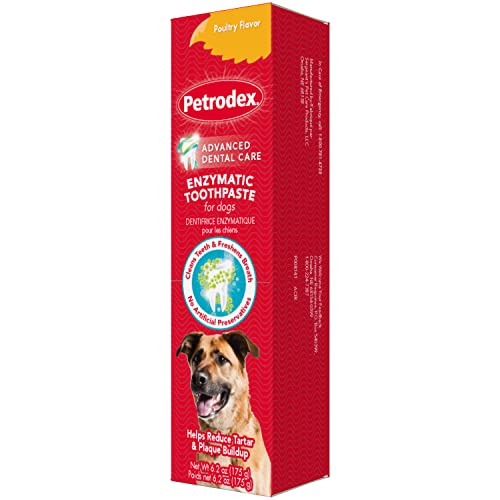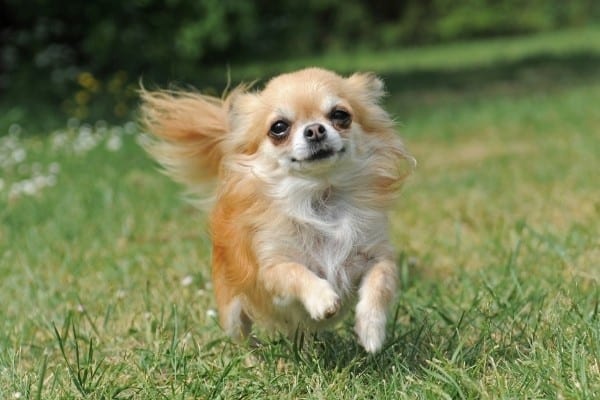
Though much of the Chihuahua’s history has been lost to time, it is believed that the breed descends from the Techichi, a small dog developed by the Toltecs of Mexico more than 1,000 years ago.
It’s assumed that when the Aztecs rose in power and dominated the region, they continued to work with the breed and diminish its size a good deal.
Today’s Chihuahua is small in size but definitely not lacking in personality.
Most people recognize the breed instantly, but many may not be familiar with some of the terms commonly used when speaking of this small dog whose presence can dominate a room.
What is an apple head Chihuahua? An apple head Chihuahua is a purebred Chihuahua who exemplifies the correct head shape according to the breed standards. They should stand between 5 – 8 inches tall and weigh 6 pounds or less, though many are bigger and heavier than the standard allows.
Whether you call them apple head Chihuahuas or simply Chihuahuas, one thing is for certain: This is not your average dog breed.
They’ll require special care and training but will reward you with loyalty, affection, and entertainment for years to come.
Take a moment to explore this tiny breed who has captured the hearts of thousands to see if a little apple head Chihuahua is right for you.
What Is an Apple Head Chihuahua?
Any Chihuahua who adheres to the breed standard in terms of correct skull and head conformation could be referred to as an apple head Chihuahua.
The term “apple head” does not denote a separate breed or variety in any way; it is more a term of description and defines how the ideal Chihuahua head should be.
The standard for the breed specifically calls for the head to have an “apple dome” skull, and when you study a show-quality Chihuahua, you do indeed note that the head is shaped similarly to an apple.
Any Chihuahua lacking the apple-shaped head is still a Chihuahua; he just falls shy of breed standards.
Apple Head Chihuahua Facts
| Origin | Likely Mexico |
| Height | 5 – 8 inches |
| Weight | 6 pounds or less, though many
are heavier |
| Coat | Long or smooth (short) |
| Colors | All colors are acceptable |
| Purpose | Companion |
| Cost | $1,200 – $3,500 |
| Temperament | Similar to a Terrier’s, feisty, alert, loyal, bold, jealous, wary of strangers |
| Trainability | High, though some may be stubborn |
| Intelligence | High |
| Exercise needs | 30 minutes per day |
| Excessive barking? | Could be problematic without
training and socialization |
| Good with other pets? | Yes |
| Shedding | Yes |
| Hypoallergenic? | No |
| Grooming requirements | Minimal |
| Health issues | Generally healthy, but heart and dental issues may occur |
| Life expectancy | 14 – 16 years |
Pictures of Apple Head Chihuahuas
To help you get a good idea of what the apple-shaped head should look like, check out the following images of different color Chihuahuas displaying the correct head type for the breed.
Brown Apple Head Chihuahua
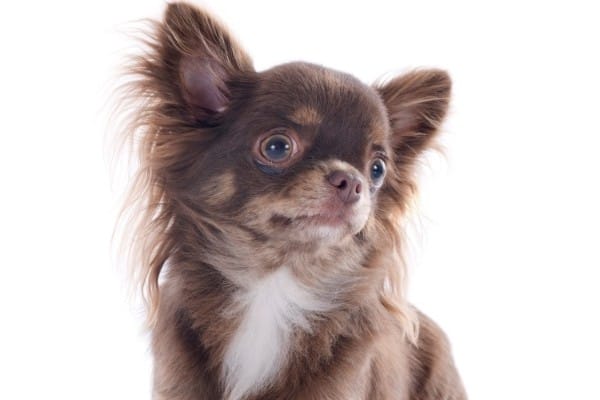
Black Apple Head Chihuahua
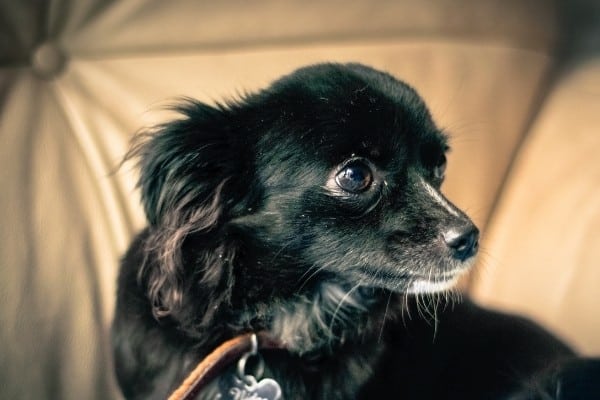
White Apple Head Chihuahua
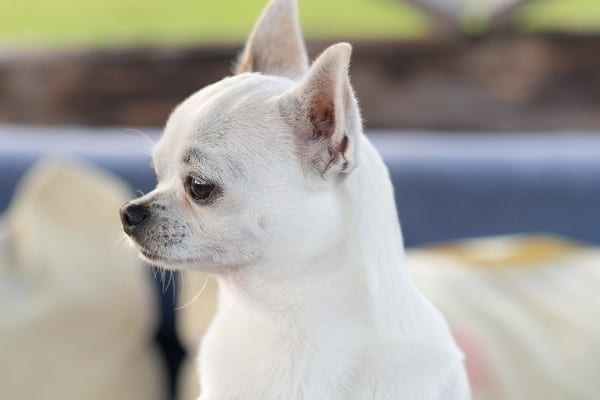
Apple Head Chihuahua Full Grown Sizes
Size tends to be an inherited feature, so knowing how big your Chihuahua’s parents, grandparents, and earlier ancestors were can give a pretty good idea of how big your little guy will grow to be.
Your breeder should also be able to give you a fairly accurate estimate of final size based on previous litters from that particular set of parent dogs.
How Big Do Apple Head Chihuahuas Get?
Most apple head Chihuahuas will grow to be between 5 and 8 inches tall at the highest point of the shoulders (withers).
Though the breed standard calls for Chihuahuas to be no more than 6 pounds, dogs averaging 8 pounds and even more are common.
Too much kibble, lack of activity, and overindulging a Chihuahua with treats and table scraps can lead to an obese dog much heavier than the set standard.
Ideal Weight
Ideal weight can vary quite a bit from one Chihuahua to another.
Those who are more stocky may weigh well over 6 pounds and still be perfectly trim, while a smaller Chihuahua may be overweight at 6 pounds.
The best way to tell if your dog is an ideal weight for his size is with a quick hands-on test and visual inspection.
Let your thumbs rest along the dog’s spine with the remaining fingers resting on the ribcage.
You should be able to feel the ribs when you gently press with your fingertips. If the ribs aren’t felt easily, the dog is overweight.
Now view the dog from the side at eye level.
There should be a slight rise from the bottom of the chest to the hind legs – not a sharp inclination, but the abdomen should appear slightly “tucked.”
Also, a faint outline of the ribs should be visible.
When you look directly down at your dog’s back, there should be a slight narrowing at the “waist.”
If your Chihuahua fails in one or more areas, it’s time to cut back on the calories and increase activity.
Your dog’s health is more important than his favorite snacks, so don’t feel guilty about practicing some tough love.
What Is a Teacup Applehead Chihuahua?
The term teacup is often used to refer to an apple head Chihuahua who weighs 4 pounds or less, though occasionally a 5-pound dog will also be deemed a “teacup.”
Many consider the term teacup to be nothing more than a marketing ploy designed to make unusually small Chihuahuas seem special or highly desirable even though they may actually be runts or the product of runts.
“Teacup” Chihuahuas are also often called micro, pocket size, tiny toy, or mini Chihuahuas, but a small Chihuahua still falls well in line with the breed standard and is simply a smaller Chihuahua.
Be aware that although “teacup” apple head Chihuahuas can be quite appealing, they are also prone to a variety of health conditions exacerbated by their small size, including:
- Bulging eyes.
- Heart disease.
- Breathing difficulties.
- Sudden drops in blood sugar.
- Hydrocephalus.
- Severe tooth overcrowding and other dental problems.
- Frequent injury.
Some tiny Chihuahuas may enjoy good health their entire lives, but this, sadly, is unusual.
Those who truly care about the best interests and health of the breed will not actively support the intentional creation of super small Chihuahuas.
If you desire a “teacup” apple head Chihuahua, please consider adopting a rescue rather than purchasing from a breeder who will then be encouraged to continue poor breeding practices and unethical marketing strategies.
Apple Head Chihuahua Characteristics
Appearance
An apple head Chihuahua is a compact, swift-moving little dog, well balanced and just slightly longer than he is tall.
The head should be rounded with an apple-shaped, domed skull; upright, large ears; round, expressive eyes (not bulging or protruding); and a short, slightly pointy muzzle.
Ideally, there is to be a right angle where the skull meets the nasal bones in between the eyes, the area referred to as the “stop.”
A Chihuahua’s neck should have a slight arch, and the shoulders should be somewhat narrow. The back is to be level, and the chest should be well developed.
The rear quarters will be well muscled, and both front and rear legs should be positioned well under the body, providing for a smooth, balanced gait.
The Chihuahua’s stance should be neither too wide nor too narrow.
According to the Chihuahua Club of America, the Chihuahua’s body should be, “Not as slender as an Italian Greyhound, nor as full-bodied as a Pug.”
So ideally, these dogs should have substance but not daintiness.
Of course, Chihuahuas who have been poorly bred may not exhibit all of the ideal physical standards, and even well-bred dogs will not be perfect.
However, knowing what a Chihuahua should ideally look like will help you weed out poor representations of the breed when you begin searching for a puppy.
Temperament/Personality

These little dogs are full of life and personality and can be an endless source of entertainment.
The breed standard states that a Chihuahua’s temperament should be similar to that of a Terrier, meaning that these little dogs should possess an “I can” attitude, confidence, and natural independence.
Chihuahua temperament tends to vary greatly from dog to dog.
Some Chihuahua indeed will be bold and confident (sometimes overly so), especially when in familiar surroundings with people they know and trust.
When out in public, however, these brave, little dogs sometimes transform into frightened, quivering pups who may lash out at anyone who comes too close.
Other Chihuahuas are just more naturally laid back both at home and in public.
For the most part, you can expect a Chihuahua to be alert, deeply attached to his owners, reserved with strangers, prone to jealousy, sensitive, intelligent, easily excited, and always ready for a snuggle.
The amount and degree of socialization plays a huge role in shaping a Chihuahua’s adult temperament, and spoiling a young puppy can put the dog on the road to becoming a domineering terror as an adult.
Energy Level
Considering their diminutive size, Chihuahuas actually have fairly high energy levels.
Unlike larger breeds with tons of energy, like Border Collies, Chihuahua don’t require lengthy periods of extensive exercise each day.
Around 30 minutes or so is usually sufficient.
So, high energy but low exercise needs? Huh?
Consider for a moment your stride length. The average person covers approximately 2.2 to 2.5 feet with every step. Sound about right?
Now picture a little Chihuahua walking beside you. For every one of your steps, that little guy will take 5 – 7 steps.
He must exert a lot more energy to cover the same amount of distance.
In fact, that’s where the majority of a Chihuahua’s energy is spent – just trying to keep up with the world around him.
When you factor in all the bouncing, running, jumping, barking, and everything else a typical Chihuahua does every day, you can see why they need and use so much energy each day.
Trembling
Many Chihuahuas shiver, shake, or tremble regularly. Some of the time, the trembling may be a sign that they are cold.
Chihuahuas originated in a warm climate and therefore do not have thick, protective skin or heavy coats.
While a double coat is allowed in smooth coats and preferred in long coats, according to the breed standard, many Chihuahuas only have a thin, single coat that does not provide much protection from the elements at all and very little body fat.
Even room temperature may seem quite chilly to some Chihuahuas.
While being chilly is often the cause of shivering, Chihuahuas also have a tendency to tremble whenever they are excited or nervous, especially when out in public.
In a relatively high-strung breed such as this, shaking with excitement, fear, or anxiety is considered to be normal.
There are certain instances in which the shaking is due to a health issue. Possible causes include:
- Hypoglycemia.
- Injury.
- Poisoning.
- Distemper.
- Seizures.
- Generalized tremor syndrome.
If you suspect your dog’s shaking is due to more than temperature, excitement, or nervousness, do not hesitate to have your Chihuahua examined by a veterinarian right away.
Long Hair
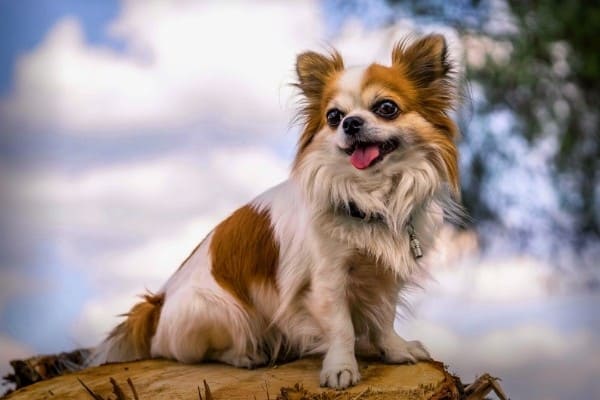
Kennel clubs recognize two distinctions or varieties in apple head Chihuahuas: long coat and smooth coat.
To the untrained eye, a long-haired Chihuahua may look like a completely different breed, but underneath that long, soft coat, the dog is identical to the short-coated variety.
Chihuahuas with long hair may or may not have an undercoat.
The hair should be roughly the same length over the entire body, except for longer feathering on the legs, tail, and feet and long fringing on the ears.
The ruff around the neck will appear much fuller in long-coated Chihuahuas than their shorter haired counterparts.
To prevent tangles and mats, long-haired apple head Chihuahuas will need to be brushed every few days to look their best.
Short Hair
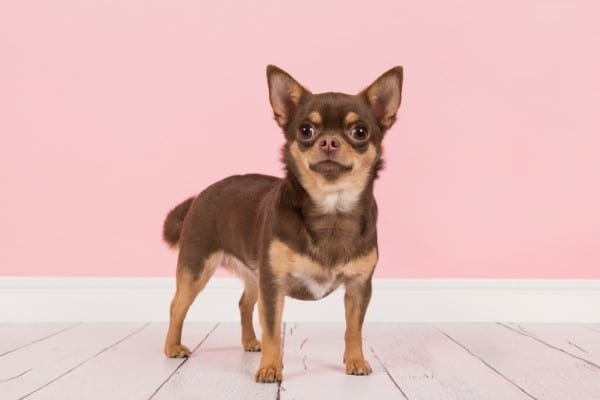
The short-haired apple head Chihuahua is more common and is the variety most people think of when picturing a Chihuahua.
The coat is smooth, glossy, and lies close to the body, and the tail should be furry. An undercoat might be present, but it is usually not.
Many smooth-coat Chihuahuas will have a ruff around their neck featuring thicker, slightly longer fur, and indeed, this is the preferred look according to breed standards.
Short-hair apple head Chihuahuas will only need to be brushed once per week or so as tangles and mats are not an issue with coats as short as this.
Trainability
Many people mistakenly assume that because an apple head Chihuahua is so portable and too small to cause any real damage (ha!) training is somewhat optional.
This is simply not true and is the reason that some folks view the Chihuahua in a negative light.
This breed absolutely needs training and is capable of learning both basic obedience commands and more complicated tasks as the following short clip demonstrates.
Sure, Chihuahuas can be a little headstrong, but with consistency and positive reinforcement, they can be trained with little effort.
These smart little dogs will need to stay focused and motivated or they will become bored or be easily distracted.
Keep training sessions short, vary the routine, and reward immediately (these all-natural training treats are perfect) when the requested behavior is performed, and you’ll be amazed at what your Chihuahua is capable of.
Barking
The apple head Chihuahua is one of those breeds that is notorious for excessive barking. However, this behavior is simply the result of a lack of training and socialization.
It is entirely possible to raise an apple head Chihuahua who is not a nuisance barker, but patience and consistency on your part will be required.
Chihuahuas bark for a wide variety of reasons, including:
- Fear.
- Excitement.
- Seeking attention.
- Small dog syndrome.
- Boredom.
- Loneliness.
- Territorial behavior.
- Separation anxiety.
- Aggression.
Proper training, especially for the quiet command, and plenty of socialization (see our Complete Socialization Guide and Checklist) can go a long way toward preventing a barking problem.
Training firmly establishes you as the leader, and once the Chihuahua understands that you are to be trusted to lead the “pack,” he’ll be more willing to obey, even when he would prefer to bark up a storm at the neighbor’s dog.
Socialization exposes the dog to as many different experiences as possible so that he can learn the appropriate way to respond to a variety of situations and not remain afraid of every little thing.
The more your apple head is exposed to, the fewer things he’ll fear, and nonstop barking shouldn’t be a problem.
In addition to training and socialization, exercise and interesting activities are important too to prevent or eliminate excessive barking.
A short walk around the neighborhood or focused play outside (think mental stimulating activities like an obstacle course) will drain both physical and mental energy, leaving the dog content, relaxed, and less likely to bark.
Small Dog Syndrome
Apple head Chihuahuas are one of the breeds most likely to exhibit small dog syndrome.
This behavioral issue is not something small dogs are born with; rather it is a learned and reinforced pattern of undesirable behaviors.
Signs include jumping or climbing on people, disobedience, wanting to be held or carried all the time, nonstop barking, and dominant or aggressive behavior toward people and animals.
The problem begins when the Chihuahua is allowed to behave inappropriately, such as stealing food from a child or aggressively barking at another dog.
Instead of providing immediate correction, the owner laughs the incident off or picks up the dog to remove it from the situation.
The undesirable behavior is thus reinforced as the dog learns that his actions have no consequences other than gaining the attention he craves.
Next time, he’ll be bolder with his behavior, and the pattern can escalate out of control quickly.
Before long, the owner finds that their Chihuahua disregards all commands, shows no respect for people, and is generally not pleasant to live with.
Some Chihuahuas with small dog syndrome will lean more toward aggressive behaviors while others will demand to be treated like royalty.
How can you prevent small dog syndrome? It’s easy.
- Do not coddle and spoil your Chihuahua.
- Firmly establish yourself as leader.
- Train, train, train.
- Treat your Chihuahua like a dog – not a person.
Apple Head Chihuahua Colors
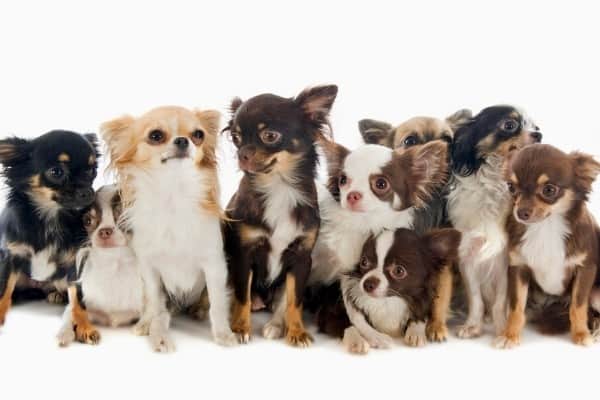
Apple head Chihuahuas can be found in a wide array of colors.
In fact, the American Kennel Club states that any color is acceptable whether it be solid, marked, or splashed with other colors. The standard colors include:
- Black.
- Black and tan.
- Blue and tan.
- Chocolate.
- Chocolate and tan.
- Cream.
- Cream and fawn.
- Fawn and White.
- Red.
Other common colors that are also accepted include:
- Black and either red, white, or silver.
- Black sabled fawn or silver.
- Blue.
- Blue and white.
- Blue fawn.
- Blue brindled fawn.
- Chocolate and white or blue.
- Chocolate brindled or sabled fawn.
- Cream and white.
- Fawn brindled black.
- Gold.
- Gold and white.
- Red and white.
- Silver and white.
- White.
As you can see, the color options are impressive, but when you consider the possible markings as well, you really get an idea of the endless variety found in Chihuahuas.
Acceptable markings include black brindling or sabling; black masks with or without white markings; blue masks; white, cream, fawn, merle, or red markings; and even spots.
How Much Do Apple Head Chihuahuas Cost?
Apple head Chihuahuas range in price considerably. Some may be $250, while others may be closer to $5,000.
It all depends on the breeder and the quality of the puppy.
Some breeders may charge one price regardless of colors, markings, or conformation, while others may price each puppy individually (this is more common).
Since all colors are acceptable and there is no minimum weight for the breed, you might expect to find no difference in price for a companion Chi based on physical features.
However, you’ll see that this is not the case. Often, “unusual” colors and small Chihuahuas are much more expensive than “ordinary” Chihuahuas.
It may not be right, but that’s the way it is.
Apple Head Chihuahua Prices
Though you may find an apple head Chihuahua for less than $1,000 from a backyard breeder, you may discover that you get what you pay for.
Conformation is not often up to breed standards and health may be less than ideal with cheaper puppies.
You might get lucky and wind up with a healthy dog; however, before money exchanges hands, ask to speak with previous clients and to view documentation of health screenings performed.
Apple head Chihuahuas from dedicated hobby breeders with a vast knowledge of the breed and years of experience typically are priced between $1,200 and $3,500, though prices closer to $5,000 aren’t unheard of.
Show-quality Chihuahuas destined for the show ring may cost close to $10,000.
Popular Apple Head Chihuahua Mixes
Chihuahuas are interbred with a large number of other breeds to create adorable, tiny designer dogs.
While the following is certainly not a complete list, it contains some of the more popular Chihuahua mixes and will give you a good idea of how incredibly cute they can be.
Shi-Chi = Chihuahua + Shih Tzu

Chug = Chihuahua + Pug

Chiweenie = Chihuahua + Dachshund

Pomchi = Chihuahua + Pomeranian

Chipoo = Chihuahua + Poodle

Chorkie = Chihuahua + Yorkshire Terrier

Cheagle = Chihuahua + Beagle

Malchi = Chihuahua + Maltese

Minchin = Chihuahua + Miniature Pinscher

French Bullhuahua = Chihuahua + French Bulldog

Chi L’Apso = Chihuahua + Lhasa Apso

Are Apple Head Chihuahuas Hypoallergenic?
Apple head Chihuahuas are not considered to be hypoallergenic and may pose problems in people suffering from allergies.
Both the long- and smooth-coat varieties can be problematic as coat length does not determine the degree of allergens produced.
Rather, it is the protein found in dander, saliva, and urine that tends to trigger allergy attacks.
How Do You Take Care of an Apple Head Chihuahua?
Apple head Chihuahuas require the same basic care that all dogs do, plus a few extra precautions.
Of course, affection, attention, healthy diet, and exercise top the list, but because of a Chihuahua’s tiny frame and delicateness, some special care is needed to ensure their safety and well-being.
Safety
Chihuahuas can easily be stepped on, tripped over, sat on, or crushed accidentally. They can also easily fall off of furniture or leap out of your arms.
Chihuahuas can fit through small gaps in fencing, choke on small objects, or topple into swimming pools.
The list of possible accidents goes on and on. Always be aware of where your dog is and supervise more than you would for larger breeds.
Using a crate to safely confine your Chi when you’re away from home or too busy to vigilantly keep watch is recommended.
Warmth
Chihuahuas are not comfortable in colder weather; in fact, they’re often chilly even at room temperature!
Sweaters and jackets will be needed (check out this colorful poncho without annoying arm holes), and constant monitoring will be necessary when outside during the winter.
Training and Socialization
To avoid raising a Chihuahua who fits the bill of the stereotypical, mean, barking, nightmare little dog, training and socialization are nonnegotiable.
Do not allow your Chi to rule the house and set his own rules.
Establish house and behavior rules early on, and do not allow him to get away with anything you would consider bad in a larger dog, such as jumping on people or nipping at strangers.
Training and socialization should begin as early as possible and continue throughout your dog’s life.
Chihuahuas are smart and will quickly figure out when you begin to relax the boundaries, so set a training routine and stick with it.
Bring your Chihuahua with you on outings as often as you like, ensuring he remains comfortable with a variety of situations and well mannered at all times.
Apple Head Chihuahua Exercise
You’ll find that an apple head Chihuahua burns up most of his energy simply following you around all day and stopping for a quick play break now and then.
For Chihuahuas who do not run around most of the day or are left behind when you go to work, 30 minutes of exercise daily should suffice.
This could be broken up into a couple of short walks or a few active play sessions indoors or outside.
Just remember that simply because they enjoy being carried and are so small doesn’t mean that they don’t need to be active.
Regular exercise, no matter what form it takes, is important for their overall health, and a well-exercised Chihuahua is more likely to be nicely behaved and calm.
Do Apple Head Chihuahuas Shed?
All Chihuahuas shed. You won’t likely see fluffy mounds of fur drifting through the house, but prepare to find some scattered hair on your furniture, floors, and clothing.
Routine brushing can eliminate shed hair before it winds up broadcast throughout your home.
How Often Should a Chihuahua Be Groomed?
Smooth-coat Chihuahuas only need to be brushed about once per week. Long-coated dogs will benefit from a thorough brushing every few days.
Baths should be given only when needed or every month or so.
There is more to grooming than maintaining the coat, however.
Ears should be cleaned with a canine ear cleaning solution and nails should be trimmed every four to six weeks.
Brush all of those tiny little teeth at least three times per week to reduce tartar and plaque buildup and avoid future problems.
Be sure to only use a dog-safe toothpaste (most dogs love this one with poultry flavor), not one for people.
How Much Does It Cost To Groom a Chihuahua?
If you take your Chihuahua to a professional groomer, you can expect to pay under $30 for a basic bath, a price significantly less than that for breeds that require trims and styling.
The basic bath usually includes a bath with a gentle shampoo, a blow dry, full-body brushing, ear cleaning, and nail trimming.
Anal sac expression, tooth brushing, conditioners, medicated shampoos, and flea/tick treatments are typically extra.
Of course, with such an easy-to-groom dog as the Chihuahua, you could always opt to take care of all his grooming needs yourself with relatively few supplies.
A gentle shampoo (we love this brand!), cotton balls for the ears, a clean towel, canine ear cleaning solution (this one promotes rapid drying to prevent infections), and a pair of nail clippers are all that’s needed.
(If you’re hesitant to clip your Chihuahua’s nails, look into a nail grinder instead. We’ve reviewed a bunch and share our favorites here.)
Apple Head Chihuahua Diet
Because of the small size of the stomach and the fact that most Chihuahua only eat around ½ cup of food each day, it is critical that every single bite is packed with nutrients.
Chihuahuas will do well on a high-quality, age-appropriate, commercial kibble designed for small breeds.
To avoid the risk of developing food allergies, formulations free of grains and chicken are often recommended.
Chihuahuas may also be fed a homemade diet, but if you opt to do so, it’s important that you work with your veterinarian or canine nutritionist to develop meal plans that will consistently meet nutrient requirements.
Apple head Chihuahuas should be given several meals per day rather than one large one.
Check the recommended feeding amounts for your dog’s weight listed on the dog food, and divide that into 2 – 3 meals to ensure that your Chihuahua is receiving adequate calories and nutrients throughout the day.
Apple Head Chihuahua Puppy Care
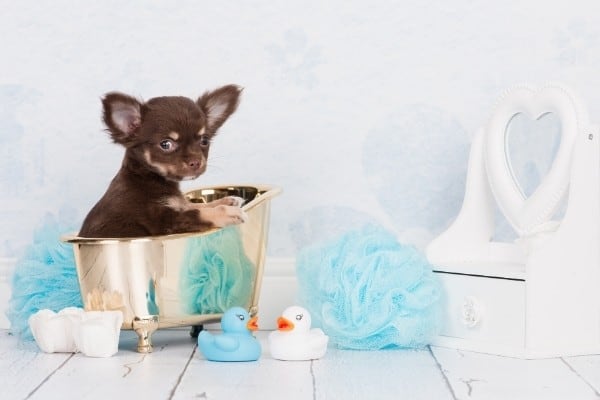
Essentials
You’ll want to have the house and yard completely puppy proofed and all puppy essentials ready to go before you bring your new Chihuahua home.
Our Puppy Checklist lays it all out for you.
In addition to the usual gear, the Chihuahua Club of America and most breeders recommend keeping some Nutri-cal (find it here on Amazon) on hand as well.
Should your puppy ever show signs of hypoglycemia, placing a small amount of nutritional gel, or corn syrup in a pinch, under the tongue can quickly revive him.
The best way to avoid hypoglycemia is to leave kibble available at all times for your pup’s first year of life and make sure he nibbles periodically throughout the day.
Take great care in ensuring your little one’s safety, don’t allow young children to play with him unsupervised, and never leave him on furniture unattended.
Because Chihuahuas are prone to dental problems, it’s important to establish a dental hygiene routine early in your pup’s life.
Nail clipping too should be introduced early so he will adjust quickly to the sensation.
Housebreaking
Begin housebreaking right away. Chihuahuas have a reputation for being difficult to potty train, but this is not necessarily accurate.
Crate training can speed the process, but you’ll still need to take him outside more frequently than you would for larger breeds.
At first, take him out every hour or so, then gradually lengthen the time between bathroom breaks.
Watch for circling behavior and sniffing the floor as these are signs that it’s time to go.
Be diligent, remain consistent, and reward him the instant he does the right thing, and you’ll be surprised how easy potty training can be.
Are Apple Head Chihuahuas Healthy?
Apple head Chihuahuas are considered to be a generally healthy breed.
Purchasing your apple head puppy from a breeder who performs genetic testing on breeding dogs to rule out hereditary conditions will decrease the odds of your pup experiencing major issues later on.
Be sure to ask the breeder if an ophthalmology evaluation, cardiac exam, and patella examination have been performed on both of the puppy’s parents.
Of course, every breed has conditions that are known to occur at higher rates, but overall, the list of possible issues is fairly short, and many Chihuahuas will live to a ripe old age.
Apple Head Chihuahua Health Problems
The most commonly seen serious health issues in Chihuahuas involve the heart. Heart disease, murmurs, mitral valve disease, and pulmonary stenosis are all possible.
Other conditions that the breed seems to be predisposed to include:
- Epilepsy – disorder of the central nervous system resulting in seizures.
- Cataracts – clouding of the lenses of the eye.
- Progressive retinal atrophy – a condition common to many breeds in which the retina and photoreceptors of the eye deteriorate until total blindness results.
- Glaucoma – accumulation of extra fluid in the eye leading to optic nerve damage and pain.
- Canine brucellosis – a reproductive disease leading to infertility and inflammation/infection in various areas of the body.
- Tracheal collapse – a partial or complete collapse or narrowing of the trachea.
- Dental issues – overcrowding of teeth, tartar and plaque buildup, bad breath, periodontal disease, and tooth loss.
- Patella luxation – condition in which the kneecap spontaneously slips out of place.
- Obesity – an overweight Chihuahua may experience worsening of existing conditions and suffer from the added strain placed on the heart, joints, and organs.
- Hypoglycemia – low blood sugar (often seen in young Chihuahuas).
Note that some Chihuahuas will have a soft spot, known as molera, on top of their head not just as newborns but throughout their lifetime.
This is completely normal for the breed and is no cause for concern.
Apple Head Chihuahua Lifespan
Lifespan can be affected by several factors, such as quality of care, diet, lifestyle, and veterinary care.
Unfortunately, a Chihuahua’s life is often cut short due to accidents.
These little dogs love to bury themselves under blankets and are sometimes squished when someone unintentionally sits on them.
Falling off of beds, attacks from other dogs, cars, and being stepped on also are main contributors to a shortened life.
The best way to ensure a long and happy life for your little apple head Chihuahua is to:
- Provide the best possible home.
- Feed a nutrient-rich diet.
- Maintain an ideal weight.
- Ensure that daily exercise needs are met consistently.
- Always be aware of where your dog is before sitting down.
- Supervise when children are playing with the dog.
- Carry the dog when in crowded areas.
- Visit the vet routinely for checkups.
How Long Do Apple Head Chihuahuas Live?
A healthy apple head Chihuahua who has been well cared for usually lives on average for 14 to 16 years.
Of course, some may not quite make it that long, and some may live to celebrate their 20 birthday, but this is not the norm.
Where Can I Find an Apple Head Chihuahua Rescue to Adopt?
The first place to look for an apple head Chihuahua in need of a loving home is Chihuahua Rescue and Transport.
This breed rescue has several branches across the country and works diligently to rescue and place as many Chihuahuas and Chihuahua mixes as possible.
Related Questions:
What is the rarest Chihuahua?
The Chihuahua breed only has two varieties: long coat and smooth coat. There aren’t any other distinguishing terms or “types” of Chihuahua.
In terms of color, however, the rarest is considered to be pure white without any additional markings or pigmentation.
True albino Chihuahuas are even rarer, but this is technically a genetic condition, not a color.
What is the difference between an Apple Head Chihuahua and a regular Chihuahua?
There isn’t any difference between an “apple head” Chihuahua and a “regular” Chihuahua. They are both simply Chihuahuas.
All Chihuahuas should, according to breed standards, have an apple-shaped, domed head, but some, such as the “deer head” Chihuahuas do not.
Regardless of the head’s shape, a Chihuahua is a Chihuahua. Period.
Sources:
https://chihuahuaclubofamerica.org/images/2014-pdfs/2011-12-03_CCAillustrated_standard.pdf
https://www.scientificamerican.com/article/bring-science-home-estimating-height-walk/
https://chihuahuaclubofamerica.org/health-committee-mission/canine-brucellosis/
Image credits: Shih Tzu Love, Pennsylvania Humane Society & SPCA, Petland Orlando East – Waterford Lakes, Furrylicious Puppy Boutique, Petland Bolingbrook, Chorkie Chile, Bliss & Joy, Petland Bradenton, Rio Rancho Animal Resource Center, Jaboo Discounts, Aphie the Chi L’apso
Last update on 2024-04-26 at 14:41 / Affiliate links / Images from Amazon Product Advertising API



